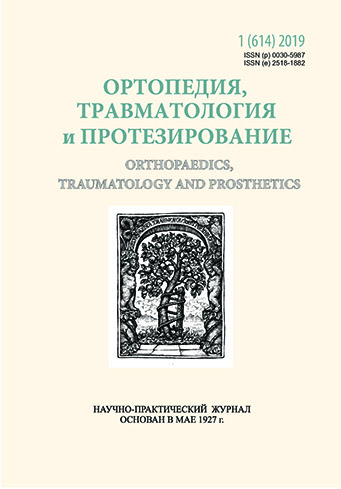Comparative analysis of behavior of the «bone – fixator – endoprosthesis» system for I–III type internal hemipelvectomy reconstruction with and without the use of a metal bar
DOI:
https://doi.org/10.15674/0030-59872019178-84Keywords:
hemipelvectomy, computer mathematical modeling, stress-strain stateAbstract
Objective: to study the changes of the biomechanical system «bone – fixator – endoprosthesis» under the loading for internal hemipelvectomy I–III type Enneking with reconstruction of the pelvic ring defect by a metalcement spacer with and without reinforcement with a metal bar.
Methods: spatial geometry of the pelvis is reconstructed with the software package «Mimics». Data are obtained by calculating Mises values.
Results: the stresses on the screws in the model were not significantly (0.27 %) larger (σmах 132.6 MPa vs. 132.3 MPa in the model without reinforcement) and did not exceed the strength limit. The maximum value of stress on polymethylmethacrylate in both models is localized in the place of contact with the pubic symphysis and is not significantly (0.4 %) higher in the model with the bar (σmах — 24.7 and 24.6 MPa, respectively). The maximum values of stress on the sacral bone in both models are defined in the zone of proximal screw installation in the lateral mass of the sacral bone, but 5 % larger in the construction without a bar — 10.6 and 10.1 MPa. The maximum permissible loads were: on the sacral bone in a model with a bar of 1.06 body weight, without a bar — 1.01; for polymethylmethacrylate — 3.05 and 3.03 body weight respectively; for metal screws — 3.44 and 3.43 body weight, respectively.
Conclusions: the usage of a metal bar in the system «bone – fixator – endoprosthesis» for internal hemipellectomy type I–III does not change the mechanical strength and stability of the model. The most susceptible to destruction was the lateral area of the sacrum in the place of the proximal screw, which should be strengthened by inserting an additional screw into the upper part of the sacroiliac joint. In the dynamics (walking, running, climbing stairs), the load of the surgery site can be 4 times higher the weight of the body, which due to the linear growth of stress values can lead to the destruction of the structure and requires the usage of additional means of support (crutches, a stick, etc.).
References
- Hillmann, A., Hoffmann, C., Gosheger, G., Rоdl, R., Winkelmann, W., & Ozaki, T. (2003). Tumors of the pelvis: complications after reconstruction. Archives of Orthopaedic and Trauma Surgery, 123 (7), 340–344. doi:10.1007/s00402-003-0543-7
- Campanacci, D., Chacon, S., Mondanelli, N., Beltrami, G., Scoccianti, G., Caff, G., & Capanna, R. (2012). Pelvic massive allograft reconstruction after bone tumour resection. International Orthopaedics, 36 ( 12), 2529–2536. doi:10.1007/s00264-012-1677-4
- Nieminen, J., Pakarinen, T., & Laitinen, M. (2013). Orthopaedic Reconstruction of Complex Pelvic Bone Defects. Evaluation of Various Treatment Methods. Scandinavian Journal of Surgery, 102 (1), 36–41. doi:10.1177/145749691310200108
- Delloye, C., Banse, X., Brichard, B., Docquier, P., & Cornu, O. (2007). Pelvic Reconstruction with a Structural Pelvic Allograft After Resection of a Malignant Bone Tumor. The Journal of Bone & Joint Surgery, 89 (3), 579–587. doi:10.2106/jbjs.e.00943
- Barrientos-Ruiz, I., Ortiz-Cruz, E. J., & Peleteiro- Pensado, M. (2017). Reconstruction after hemipelvectomy with the ice-cream cone prosthesis: what are the short-term clinical results? Clinical Orthopaedics and Related Research, 475 (3), 735–741. doi: 10.1007/s11999- 016-4881-5
- White, E. A., Learch, T. J., Matcuk G., & [et al.] (2013). Review of hemipelvectomy endoprostheses: Indications and imaging. Applied Radiology, 42 (6), 23.
- Johnston, J. O., & Gray, R. M. (1990). Hip reconstruction following in-ternal hemipel¬vectomy for primary periacetabular sarcomas. La Chirurgia degli Organi di Movimento, 75 (1 Suppl), 249–252.
- Satcher Jr., R. L., O’Donnell, R. J. & Johnston, J. O. (2003). Reconstruction of the Pelvis After Resection of Tumors About the Acetabulum. Clinical Orthopaedics and Related Research, 409, 209–217. doi:10.1097/01.blo.0000057791.10364.7c
- Japie, I. M., Bădilă, A., Rădulescu, R., Mitroi, E., Bujdei, A., Dumitru, A., & Cîrstoiu, C. (2018). Pelvic reconstruction with bone cement and total hip prosthesis after resection of chondrosarcoma. Case Report. Romanian Journal of Orthopaedic Surgery and Traumatology, 1 (1), 7–12. doi:10.2478/rojost-2018-0003
- Guder, W. K., Hardes, J., Gosheger, G., Henrichs, M., Nottrott, M., & Streitbürger, A. (2015). Analysis of surgical and oncological outcome in internal and external hemipelvectomy in 34 patients above the age of 65 years at a mean follow-up of 56 months. BMC Musculoskeletal Disorders, 16, 33. doi:10.1186/s12891-015-0494-5
- Vyrva, O., Mikhanovsky, D., & Karpinsky, M. (2015). Biomechanical study of stress-strain states of the system «endoprosthesis humerus» in terms of tumor resection. Orthopaedics, Traumatology and Prosthetics, 0 (3), 14. doi:10.15674/0030-59872015314-20. (Ukraine)
- Hua, Z., Fan, Y., Cao, Q., & Wu, X. (2013). Biomechanical Study on the Novel Biomimetic Hemi-Pelvis Prosthesis. Journal of Bionic Engineering, 10 (4), 506–513. doi:10.1016/s1672-6529(13)60244-9
- Enneking, W. F., & Dunham, W. K. (1978). Resection and reconstruction for primary neoplasms involving the innominate bone. The Journal of Bone & Joint Surgery, 60 (6), 731–746. doi:10.2106/00004623-197860060-00002
- Kubichek, M., & Florian, Z. (2009). Stress strain analysis of knee joint. Engineering Mechanics, 16 (5), 315–322.
- Zatsiorskiy V. M. (1981). Seluyanov Biomehanika dvigatelnogo apparata che-loveka. Moscow : Fizkultura i sport. (Russia)
Downloads
How to Cite
Issue
Section
License
Copyright (c) 2019 Viktor Kostiuk, Igor Lazarev, Anatolii Diedkov, Maxim Skiban

This work is licensed under a Creative Commons Attribution 4.0 International License.
The authors retain the right of authorship of their manuscript and pass the journal the right of the first publication of this article, which automatically become available from the date of publication under the terms of Creative Commons Attribution License, which allows others to freely distribute the published manuscript with mandatory linking to authors of the original research and the first publication of this one in this journal.
Authors have the right to enter into a separate supplemental agreement on the additional non-exclusive distribution of manuscript in the form in which it was published by the journal (i.e. to put work in electronic storage of an institution or publish as a part of the book) while maintaining the reference to the first publication of the manuscript in this journal.
The editorial policy of the journal allows authors and encourages manuscript accommodation online (i.e. in storage of an institution or on the personal websites) as before submission of the manuscript to the editorial office, and during its editorial processing because it contributes to productive scientific discussion and positively affects the efficiency and dynamics of the published manuscript citation (see The Effect of Open Access).














